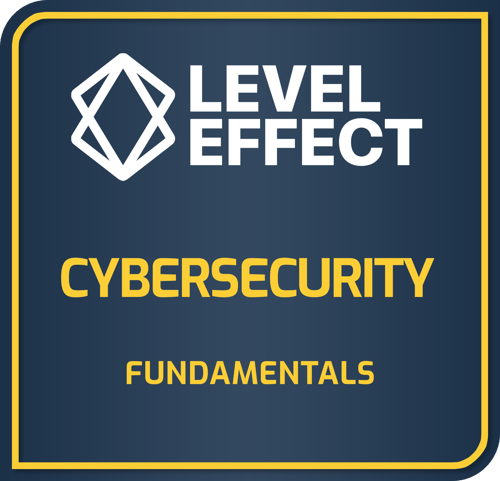Free Training
Premium Training
Tuition & Scholarships
Certification and Badging
Cybersecurity Fundamentals V2
Part two of our three-part Cybersecurity Foundations training pathway.

In this course, you'll...
-
Understand the Cybersecurity Industry: encompassing its application in physical, network, system, and data security contexts, across various domains
-
Learn Cryptographic Concepts: including hashing and encoding for data integrity and secure representation
-
Operate ELK as a SIEM: to develop expertise in log inspection for Windows and Linux systems, and identify malicious activity
-
Work with Cyber Threat Intelligence: to understand the utilization of actionable, timely, and relevant information for identifying, comprehending, and mitigating cybersecurity threats
-
Triage Windows & Malware: to gain a deep understanding of processes, threads, and dependencies to triage real malware samples!
Cybersecurity Fundamentals Curriculum
Check out the syllabus here: All Fundamentals Syllabus and some screenshots from labs you'll complete below:
-
Cybersecurity Industry
-
Contexts of Security
-
Security Controls
-
CIA Triad and Defense in Depth
-
IAM Zero Trust and Cyber Hygiene
-
Cyber Threats and Nation State Threat Actors
-
Threat Actors Continued
-
Threat Vectors
-
Knowledge Check: Cybersecurity Industry
-
-
Cryptography
-
What is Cryptography?
-
Hashing, Encoding, Symmetric & Asymmetric Encryption
-
Lab: Hashing and Encoding
-
Lab: Ciphers and Symmetric Encryption
-
Lab: Asymmetric Encryption
-
Lab: Digital Signatures & Certificates
-
Lab: Cooking with the Cyberchef
-
Knowledge Check: Cryptography
-
Challenge: Encrypt a Message to the Community!
-
-
Logging for Security
-
Logs and Sources
-
SIEM and SOAR
-
Lab: Windows Event Logs
-
Lab: Linux Logs
-
Lab: Intro to ELK and Queries
-
Lab: ELK Investigation
-
Lab: Intrusion Detection with YARA
-
Knowledge Check: Logging for Security
-
Challenge: All Seeing YARA
-
-
Cyber Threat Intelligence
-
Cyber Threat Intelligence (CTI)
-
CTI Types and Sources
-
CTI Lifecycle and MITRE ATT&CK
-
Lab: Industry Breach Reports with Verizon DBIR
-
Lab: Threat Actor Report Analysis
-
Lab: Threat Actor TTPs with MITRE ATT&CK
-
Lab: Cyber Kill Chain, Pyramid of Pain, Diamond Model
-
Knowledge Check: Cyber Threat Intelligence
-
Challenge: Intelligence on Indicators of Compromise
-
-
Windows Triage & Malware Analysis
-
Processes, Threads, and Virtual Memory
-
Lab - Task Manager vs Process Explorer
-
Birth and Lifecycle of a Process
-
Lab - Multi-threaded Applications
-
Registry Structure
-
Lab - Windows Registry
-
EXEs, DLLs, and Threads
-
Windows Architectures and Key Components
-
Operating System Security Measures
-
Lab - Windows Security
-
Lab - Malware Persistence Analysis: The Autorunner
-
Lab - Malware Process Analysis: Process Me If You Can
-
Lab - Malware Network Analysis: Nettin But Time
-
Practical Quiz - Malware Triage
-
-
Cybersecurity Fundamentals Assessment
-
Assessment: Cybersecurity Fundamentals
-
Survey: Cybersecurity Fundamentals Course Feedback
-

Working with layered obfuscation analysis and tools like CyberChef is important for decoding complex security threats and enhancing defensive strategies in cybersecurity.

Understanding cryptographic functions is key to securing data, validating identities, and ensuring secure communications in cybersecurity practices.

Being able to use digital signatures and certificates is important for verifying authenticity and ensuring secure transactions in cybersecurity.

Inspecting event logs for malicious activity is essential for early detection of security incidents and effective response in cybersecurity.

Writing detection rules and using tools like Yara is important for identifying threats and enhancing protective measures in cybersecurity.










Cybersecurity Fundamentals is part of our Cybersecurity Foundations training pathway.
Because each course builds off its predecessor, we strongly recommend completing the Cybersecurity Foundations training pathway in this order:
-
IT Fundamentals
-
Cybersecurity Fundamentals (You are here!)
-
Compliance Fundamentals






